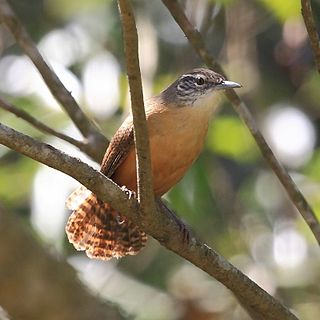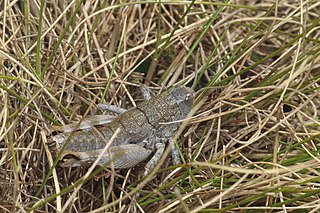
Pipistrellus is a genus of bats in the family Vespertilionidae and subfamily Vespertilioninae. The name of the genus is derived from the Italian word pipistrello, meaning "bat".

The Nesomyidae are a family of African rodents in the large and complex superfamily Muroidea. It includes several subfamilies, all of which are native to either continental Africa or to Madagascar. Included in this family are Malagasy rodents, climbing mice, African rock mice, swamp mice, pouched rats, and the white-tailed rat.
Leiocassis is a genus of bagrid catfishes found mostly in Southeast Asia with some species occurring in China.
The greater Papuan pipistrelle is a species of vesper bat found in Papua New Guinea and Irian Jaya.

Delany's mouse or Delany's swamp mouse is a species of rodent in the family Nesomyidae. It is the only species in the genus Delanymys and the only extant member of subfamily Delanymyinae, which also contains the fossil genus Stenodontomys. It was previously placed in subfamily Petromyscinae, but it is apparently not closely related to Petromyscus. It is found in Democratic Republic of the Congo, Rwanda, and Uganda. Its natural habitats are subtropical or tropical high-altitude shrubland and swamps. It is threatened by habitat loss.
Barbour's rock mouse is a species of rodent in the family Nesomyidae. It is found only in South Africa. Its natural habitats are subtropical or tropical dry shrubland and rocky areas. It is threatened by habitat loss.
Petromyscus is a genus of rodent in the family Nesomyidae. It is so distinct from other rodents that it is placed as the only genus in subfamily Petromyscinae. In previous classifications, Delanymys brooksi has also been placed in the subfamily. They are found in southwestern Africa. These animals have a sharp lower point to their V-shaped infraorbital canal. Their molars are intermediate between the ancestral cricetid style tooth and the dendromurine style tooth.
The Brukkaros pygmy rock mouse is a species of rodent in the family Nesomyidae. It is found in Namibia and South Africa. Its natural habitat is subtropical or tropical dry shrubland.
Shortridge's rock mouse is a species of rodent in the family Nesomyidae. It is found in Angola and Namibia. Its natural habitat is subtropical or tropical dry shrubland.

The buff-breasted wren is a species of bird in the family Troglodytidae. It is found in the Amazon Basin of northern Brazil and Amazonian Colombia, Ecuador, Peru and northern-border Bolivia, and also the Guianan countries of Guyana, Suriname, and French Guiana. It occurs in non-Amazonian regions of Venezuela and Colombia and its range extends into eastern Panama.

Scotophilus is a genus of vespertilionid bats commonly called yellow bats. They are found in southern Asia and Africa. They are the only members of the tribe Scotophilini.
The montane Atlantic Forest rat is a South American rodent species of the family Cricetidae. It is endemic to part of the Atlantic Forest region of southeastern Brazil, where it is found at elevations from 1000 to 2700 m in noncontiguous mountain ranges. Its karyotype, like that of closely related Delomys dorsalis, has 2n = 82, but the fundamental numbers of the two species differ. While it is not thought to be in present danger of extinction, habitat destruction and grassland fires are considered to be threats.

Delomys is a genus of South American rodents in the tribe Thomasomyini of family Cricetidae. Four species are known, all found in the Atlantic Forest of Argentina and Brazil. They are as follows:

Sody's yellow bat or Sody's yellow house bat is a species of vesper bat. It is native to Island Southeast Asia, where it is found in Indonesia, Malaysia, and Timor-Leste. This species was described in 1936.
Streptomyces collinus is a bacterium species from the genus of Streptomyces which has been isolated from soil in Baden in Germany. Streptomyces collinus produces ansatrienin A2, ansatrienin A3, ansatrienin B, naphthomycin A, collinomycine, toromycin, streptocollin, kirromycin and rubromycine.

Cleistanthus collinus is a plant species first described by Roxburgh, with its current name after Bentham and Hooker; it is included in the family Phyllanthaceae. The IUCN categorizes this species as vulnerable. No subspecies are listed in the Catalogue of Life.

Astragalus tweedyi, or Tweedy's milkvetch, is a perennial herb in the pea family. It is native to Washington and Oregon in the Pacific Northwest of the United States.
Lobostemon collinus, the pyjamabush or iron healthbush, is a species belonging to the forget me not family. It is known only from the fynbos biome of the Western Cape of South Africa.

The Green Rock-hopper grasshopper, Brachaspis collinus is an alpine species of short-horned grasshopper in the family Acrididae. It is found in New Zealand in the mountains of northern South Island, above the tree line and as high as 2000 m asl. In New Zealand alpine grasshoppers can freeze solid at any time of the year and are alive when they thaw out when temperatures rise.










